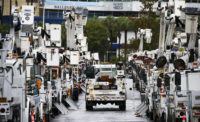Hurricane Fiona's sweep across Puerto Rico brought heavy rains, flooding and landslides, knocking out power to the entire island that still is rebuilding its electric grid after the devastation of Hurricane Maria in 2017. The Category 1 hurricane, which struck the island’s southwest coast on Sept. 18, caused extensive damage as forecasters warned of historic levels of rain through the next few days, the Associated Press reports.
Up to 30 in. of rain was expected in Puerto Rico’s southern region, triggering floods and landslides and knocking out the power grid in what the AP reports Gov. Pedro Pierluisi calling "catastrophic" damages.
Flooding also washed away a bridge in Utuado that AP says was installed by the National Guard after Hurricane Maria.
LUMA Energy, the private consortium that has operated Puerto Rico’s electrical transmission and distribution since 2021, stated in an announcement Sept. 19 that crews worked throughout the night to assess damage and perform critical repairs—working with the island’s utility, the Puerto Rico Electric Power Authority (PREPA) and private generators to increase generation and reenergize the electric grid following the island-wide blackout.
“While power restoration has now occurred for more than 100,000 customers, LUMA crews continue to work to stabilize the grid,” said its Public Safety Manager Abner Gomez in the announcement. “We will continue to work non-stop until every customer is restored and the entire grid is reenergized.” LUMA is a joint venture of units of Canada-based energy firm ATCO Ltd and U.S. energy contractor Quanta Services.
According to LUMA, crews restored power to hospitals and more throughout the early-morning hours of Sept. 19, and to more than 100,000 of its 1.5 million customers by 5:30 a.m. in the capital of San Juan as well as on Bayamon Corozal, Toa Alta and Toa Baja.
LUMA stated that it has deployed "1,648 utility field crews and an additional 339 contractor resources," including 69 construction and maintenance crews and five helicopter crews.
PREPA reported 66% of its customers, a total of 837,117, without water service just before noon Sept. 19, with 2,146 people reported staying in 113 shelters across 74 municipalities.
The National Hurricane Center forecasts continuing rain that threatened catastrophic flooding along with mudslides and landslides into the morning of Sept. 20, as the hurricane is forecast to strengthen after moving away from Puerto Rico and the Dominican Republic.
President Joe Biden declared a state of emergency Sept. 18 to make federal emergency aid available for Puerto Rico and authorizing the Federal Emergency Management Agency to coordinate disaster relief efforts.
Puerto Rico is still recovering from Hurricane Maria, which caused more than $100 billion in damages, affecting and damaged more than 300,000 homes, ENR reported in 2018, and resulted in the direct or indirect deaths of 4,645 people.
The AP says the Puerto Rican government has completed 21% of more than 5,500 official post-hurricane projects.
In January 2021, Burns & McDonnell was announced as program manager to support grid rebuilding and modernization efforts for PREPA.
Puerto Rico was set to receive $9.9 billion from FEMA and up to $18 billion in federal Community Development Block Grant-Disaster Relief funds, ENR reported at the time, as Burns & McDonnell worked with PREPA and others to plan a 10-year plan to rebuild and strengthen the island’s power system.





